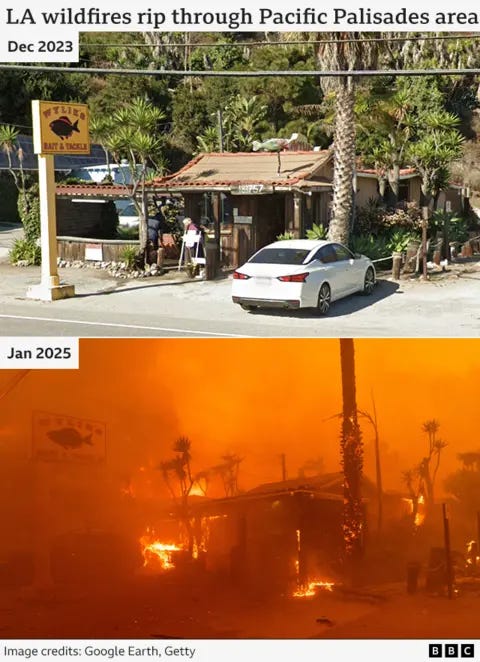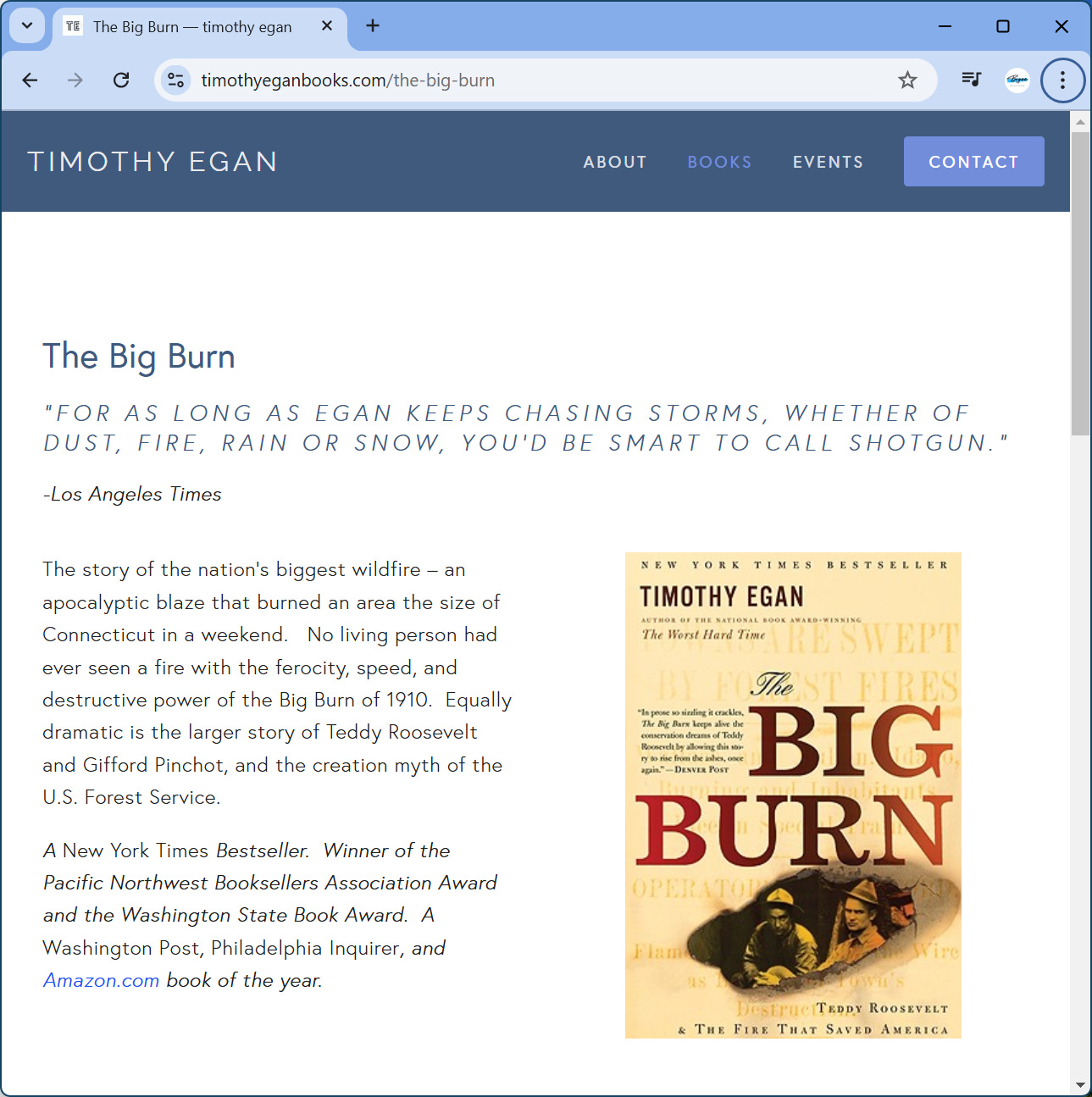LA
🔥 None of us were ready for this
Last week, I closed with this line: Are you ready for what’s next?
Confession: I wasn’t ready.
The first fire started at 10:30am Tuesday1. Some time later, I received a notification on my phone from the BBC. I checked out the news and went back to work. By Tuesday evening, a second fire had started.
By Wednesday morning, it was the lead story in The New York Times’ The Morning briefing:
Wildfires are raging out of control across parts of Los Angeles. A fierce windstorm is fanning embers, billowing dangerous smoke across the city and turning the sky an apocalyptic red.
At least four blazes are spreading in Southern California, near the scenic coast, in Malibu and the Pacific Palisades, as well as further inland. Firefighters are struggling to work in the wind, and the fires are uncontained.
At least 30,000 people have fled. Some abandoned their cars and escaped on foot to avoid roads jammed with traffic. Residents of one nursing home evacuated on gurneys, officials said. Homes, landmarks and places of worship have been destroyed, and officials warned more destruction is coming.
Wednesday evening, I stayed up reading the news. I checked the BBC, the Los Angeles Times, NPR, The New York Times, and Wall Street Journal.
And after more than a day of historic tragedy, the reality was setting in that it isn’t even close to over.
-WSJ
We have family, friends and colleagues in LA. You probably do, too. You may even be in LA2. If you are, my heart goes out to you.
I took a screenshot to capture where the fires were and shared it with my wife.
I continued on. The WSJ had a particularly moving story (gift link) under this headline:
The images and first person accounts were striking. Deeper in the WSJ article, was this:
State Farm last year announced it was dropping 69%, or almost three-quarters, of its home-insurance customers in the Pacific Palisades zip code of 90272, as part of a cull of some 30,000 policies in the state. A spokesman for the insurance giant said at the time—and repeated recently—that the non-renewals were designed to “address areas where the company has an overconcentration of risk,” adding that the “decision was not made lightly.”
California regulators have gone all out in recent months to woo the companies back, agreeing to rate hikes that are far higher than the historic norm for the state. Rules passed late last year meet many of the industry’s demands, such as allowing insurers to base their rates on predicted future losses from wildfires, rather than—lower—historic losses.
There were growing concerns about the fires exacerbating California’s stark housing shortage, and questions about how prepared the region was for this event and who or what was to blame for the unfolding disaster.
I’ve been aware that some insurance companies have exited California or other markets from prior news articles but this was the first time I recalled seeing such specific data. There is a lot one could say about concentration and diversification of risk, the ability to accurately assess and price for risk to ensure sustainability (and inform choices), and climate risk more broadly. I may return to these themes in a future issue.
On Wednesday night, however, I kept refreshing the NYT live feed until my eyes were bleary.
There was, of course, plenty of other stuff happening this week. But, as the Los Angeles Times noted:
The stunning devastation that engulfed Pacific Palisades, Altadena and other neighborhoods entered the national consciousness through wall-to-wall TV news coverage, overshadowing major news events such as the funeral of former President Carter and the sentencing of Donald Trump in his New York hush money case. The unprecedented inferno filled screens with shocking images since Tuesday.
I checked the Los Angeles Times when I got up this morning. The death toll had risen to 13 and more than 12,000 structures have now been damaged or destroyed.
The Los Angeles Times has a summary of each fire by the numbers. I checked a few other sources.
The BBC Visual Journalism Team has put together a collection of maps and images (before/after pairs and also interactive aerials with slider bars) that really helps to convey the scale of this situation. It’s worth a visit. Here are two:


The BBC also has a video of how the LA fires have unfolded over four days (2:38).
Here is the front page of today’s Los Angeles Times:
I can’t stop thinking about The Big Burn. I read it more than a decade ago and it is seared into my memory.
I have great respect for fire.
When I was a little kid, I was eating breakfast in a restaurant with my parents one morning when I saw a motorhome go up in flames at the gas station across the street.
Later in my childhood, on a family fishing trip, I watched my dad and older brother leap into action with a bucket brigade (using our Playmate cooler no less!) to help put out a fire started by someone who thought burning their toilet paper in a dry environment was a good idea.
My sister fought forest fires the year Yellowstone burned. That was when I first learned about smokejumpers.
In 2017, the Columbia River Gorge went up in flames and I saw the horror from across the Columbia River as two friends and I drove through the Gorge to visit another friend out of state.
In 2020, more than 1 million acres burned in Oregon, destroying multiple towns. I’ve seen the devastation first hand. In one town dear to my heart, virtually all that remained was the sign to the restaurant where my dad, brother and I always ate when we would go hunting when I was a kid.
I have great respect for fire.
As I was writing this, I see that The New York Times has reported that the Getty Center, a place I fell in love with when I first visited, is now within the mandatory evacuation zone. Deep breath.
Earlier this week, the Los Angeles Times shared this:
Longtime CNN correspondent Nick Watt told viewers on Wednesday how after he finished his reporting he was headed to his home in Santa Monica to hose it down, hoping it would deter embers from starting a blaze.
“It’s extraordinary to cover something like this in your own community,” he said. “I’ve been covering fires for a long time. You have sympathy for people. Now I have empathy.”
My heart goes out to everyone being affected by this.
I didn’t set out to write about the fires in LA but they have been and continue to be on my mind and I needed to. Thank you for reading.
I hope you have a wonderful weekend.
Be well,
-Bryce
PS: Here are some ways you can help from the NYT.
Source: Los Angeles Times, https://www.latimes.com/california/story/2025-01-08/southern-california-wildfires-by-the-numbers
According to Substack, more of my US readers are in California than in any other state.








WSJ: The Extraordinary Defense of the Getty Museum Against the L.A. Fires
Flames made it to within 6 feet of the Getty Villa and yet it still stands. Inside the museum's powerful tools for disaster preparedness.
https://www.wsj.com/arts-culture/fine-art/getty-museum-los-angeles-fires-villa-center-1f600dae?st=XW3Rrf